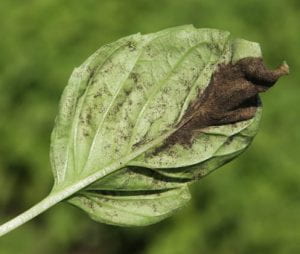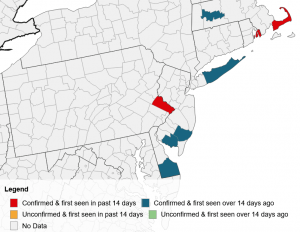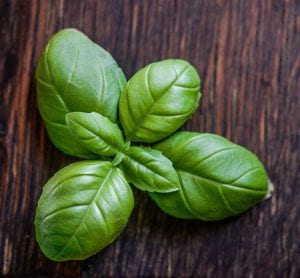This article appeared in the July 2021 Issue of Gardening in Orange County.
Basil downy mildew has been a persistent deadly disease of greenhouse and garden basil crops in the US for over 10 years. It is caused by the pathogen Peronospora belbaharii. This fungus-like oomycete can infect the plant during its whole lifecycle from seed to full maturity. Pesto lovers beware since sweet basil (Ocimum basilicum) is the most susceptible.
Signs and Symptoms

Usually the first symptom is a non-specific chlorosis or yellowing of the top portion of the lower leaves of the basil plant that then travels up the plant. The discoloration is contained within the borders of the major veins of the leaf. The affected leaves will eventually wilt or curl, die and turn brown. A distinguishing feature of basil downy mildew is the fluffy purplish gray spores that grow on the undersides of the leaves. Unfortunately, infected plants and seeds may not show any signs or symptoms especially if in cool, dry conditions.
Transmission

Peronospora belbaharii is primarily spread via wind-borne spores called sporangia. Contaminated seeds, other basil plants, garden tools and gloves are other forms of transmission. The spores thrive in warm, humid and wet conditions but can still infect plants and reproduce in temperatures as low as 59° F.
Basil downy mildew does NOT overwinter here in New York. It can NOT survive in the soil or on dead plant tissue (like many pathogens). Each year spores are carried up from the southern United States by the wind.
Management
Basil downy mildew is difficult to treat once the disease has been established. High temperature steam treatments have shown promise in eradicating the pathogen on basil seeds. There has also been some success in developing disease resistant cultivars for less susceptible varieties of basil such as red leaf, lemon, and spicy basil, but developing disease resistant cultivars of sweet basil has proven more challenging. According to research at Cornell University evaluations the sweet basil cultivars ‘Eleonora’,, ‘Prospera’ and ‘Pesto Besto’ may be some good options.
Since basil downy mildew is an oomyete and not a true fungus, fungicides have limited value and are not recommended for the home gardener. Because basil downy mildew does NOT overwinter in New York, removing crop debris at the end of the season and crop rotation are not helpful for management of basil downy mildew.
Monitoring and cultural practices have been most successful especially in the home garden and greenhouse settings. Monitoring all seedlings and plants for yellowing leaves and gray downy growth is imperative. Once you determine your plant is infected, immediately harvest the unaffected leaves for culinary purposes, and then remove the plant and dispose of it in the garbage.

The annual spread of basil downy mildew is monitored and confirmed cases are tracked. To have a better idea as to when your plants are likely to become infected, you can follow the spread of basil downy mildew on the ‘Basil – Ag Pest Monitor‘ website and sign-up for alerts.
Reducing leaf wetness can be helpful in preventing infection. Always water basil plants at the base either by hand or using a drip irrigation system. Plant basil in full sun and maximize your spacing between plants to provide good air movement. These practices allow the leaves to dry quickly after rain or dew. If you are growing basil indoors or in a greenhouse, an effective way to increase air circulation and reduce leaf wetness is by directing a fan towards the plants.
If you accidentally eat a piece of basil with downy mildew, don’t worry. Pathogens that cause diseases in plants are different than the pathogens that cause disease in humans. It’s not poisonous to humans and should not cause you any symptoms.
Resources

Basil Downy Mildew Alerts – Basil: Ag Pest Monitor
Basil Downy Mildew Map – Basil: Ag Pest Monitor
How Gardeners Can Manage Downy Mildew in Basil – Cornell University
Managing Downy Mildew in Gardens and Commercial Plantings – Basil: Ag Pest Monitor
